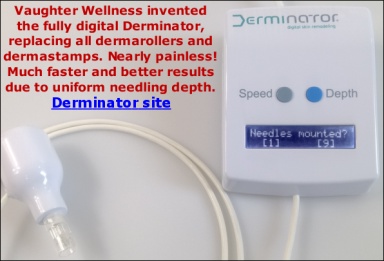Yes, I think there is good chance needling will help. Buy a 1.5 mm dermastamp and stamp your scars every three weeks. Let us know whether it helped. It will take several months to see results so be patient.
I had to laugh when I read all the hype about the "Veinwave", especially about their claims that it is a completely new, modern, innovative, magical way of treating dilated veins.
The Veinwave (a misnomer) is based on ordinary thermocoagulation, which is a method that has been known for centuries and it has been used to zap spider veins already for decades. It is nothing new.
A small needle is inserted into the skin, very near or into the vein, and then a current is passed through for less than a second. This current is absorbed by the surrounding tissue, heating it up. The high temperature seals the walls of the dilated vein.
The whole vein is zapped spot by spot.
We've investigated exactly how Veinwave works and that wasn't easy - they have put up a wall of nonsense to mask the actual operating principle.
They use pseudo-scientific terms such as "monopolar energy" where they mean good old DC current. They also fence with terms like "radiofrequent waves" and "microwaves". Their device doesn't work like that at all.
This is their FDA submission for clinical trials, where they use a lot of nonsense-words but it becomes clear how it really works: A needle passes DC current with a frequency of 4 MHz through the skin.
A high frequency current is used so that they can fool people into believing their fancy sales mumbo-jumbo about "radiofrequent waves", pretending it's a very special machine so you should pay a lot for the treatment.
https://http://www.owndoc.com/pdf/veinwave.pdfSo their device uses "classical" vascular thermocoagulation, and that technique is so simple and so cheap that a similar device can be built by any twelve-year old with a soldering iron, using literally no more than nine dollars in parts from Radio Shack, including a 9 volt battery. Even including the superfluous 4 MHz signal, because that can be generated by the most expensive part of the design: A LM555 microchip, costing $1.99:
https://http://www.radioshack.com/product/index.jsp?productId=2062596(So nice to have hubby back me up when things get really technical - that was also the reason that my answer was delayed - Thanks John :-)
This same principle has been used for over 100 years to permanently remove unwanted hairs. The needle is inserted into the hair follicle and the hair bulb+germ cells are destroyed by heat. Thermolysis/Electrolysis has been so far the most effective way of permanent hair removal but it is very laborious and slow.
Lasers, in spite of their "magical" reputation are much less efficient to treat dilated veins or unwanted hairs because the treatment is not as targeted and it cannot be set up too high because it is prone to cause collateral damage to the skin.
Lasers also heat up the skin. The tissue absorbs light from the laser and that heats it up.
Everything in the skin absorbs laser light but some parts (for example dark colored parts) absorb it better, especially if specific wavelengths of light are used.
Thus you can target hemoglobin in blood and destroy (seal) spider veins by heat.
With laser epilation, you target melanin in the hairs and the heat will temporarily weaken the hair bulb. You can target tattoo pigment etc.
You can stimulate collagen production by slightly heating up the skin or use more energy and evaporate a layer of skin or just fractions of skin (Fraxel). The problem is that even if you target a specific part of the skin, the other parts heat up as well and in some unfortunate cases, the heat destroys for example melanocytes (pigment producing cells) as a collateral damage and you end up with hypopigmented spots or with scars and hyperpigmentation when too much heat was used or the skin overreacted to heat.
To show you how fine the line is between positive and disastrous results, there were cases with laser epilation, where the treatment actually stimulated the growth of thicker and coarser hairs in the area above the lip because to avoid potential burning of this sensitive area, the epilation laser was set too low and instead of paralyzing the hair bulbs with intensive heat, the bulbs were just slightly heated which actually stimulates their growth..
The skin itself also contains melanin (the darker the skin the more melanin it contains) and setting the epilation laser too high can burn the skin.
Using enough energy to destroy or stimulate certain targets but not too much in order not to burn the (surrounding) skin is very difficult and what works for one person can be too much or not enough for the other.
Incidentally, needling or dermarolling cannot help with an indentation after IPL or laser treatment if it is caused by receded (destroyed) fat. It can only improve an indentation caused by damaged skin.
Obviously, targeted treatments such as thermolysis or thermocoagulation are more effective but they are also very intensive and in some unfortunate cases or with improper settings, they can burn the skin and leave scars or pigmentations.





